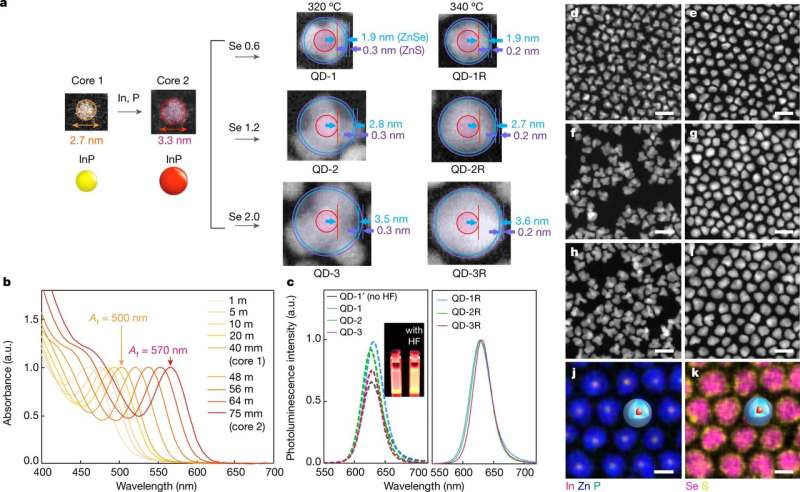November 29, 2019 report
Samsung researchers: More efficient quantum dots without heavy metals

A team at Samsung Advanced Institute of Technology has announced that they have improved quantum dot (QD) technology for use in large displays by developing QDs that are both more efficient and have no heavy metals. In their paper published in the journal Nature, the group describes their work and their plans for the future. Alexander Efros, with the Naval Research Laboratory, in Washington D.C. has published a companion piece in the same journal issue outlining the work by the team at Samsung.
Quantum dots are nanoscale semiconducting crystals that have unique optical and electronic properties due to quirks of quantum mechanics. Since their development in the 1980s, scientists have been finding many uses for them in optical devices. Unfortunately, as Efros notes, they suffer from two problems that have prevented them from being fully utilized. The first is that they are based on cadmium, a toxic heavy metal. The second is the QD phosphors that are used in display devices—they are not self- emissive, which means they need to be replaced by QD light-emitting diodes in order for them to be competitively efficient. Notably current Samsung QLED TV screens do not use the QLEDs as a source of light—instead, LCDs produce backlight which is then absorbed by a film of quantum dots. In this new effort, the group at Samsung has made progress towards addressing both problems. Their development comes just a month after the company announced that it was planning on investing $11 billion in the technology over the next five years.
The new approach by the researchers involved using a new structure that stops oxidation from degrading the QD core—it also involved creating a shell around it to keep energy from leaking out. The team also shortened the ligand on the shell surface to promote speedier current flow. And they also replaced cadmium with indium phosphide, a much more Earth-friendly material.
The researchers report that their changes improved quantum efficiency by 21.4 percent—and increased QD lifetime by approximately a million hours. They suggest their work indicates that the use of quantum dots for self-emissive display technology will soon be viable.
More information: Yu-Ho Won et al. Highly efficient and stable InP/ZnSe/ZnS quantum dot light-emitting diodes, Nature (2019). DOI: 10.1038/s41586-019-1771-5
Journal information: Nature
© 2019 Science X Network


















